You may not know the name Kristie Wolfe. But if you’ve used Airbnb, you’ve likely seen her properties.
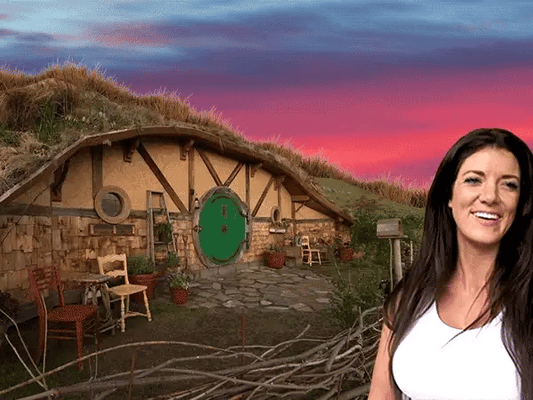
Over the past decade, Wolfe has built some of the most popular and unique vacation rentals on the platform, including:
- A jungle treehouse in Hawaii
- A real-life hobbit hole in Washington
- A converted fire lookout in the middle of a forest
- A potato-shaped tiny home in Idaho
In Airbnb circles, Wolfe is a legend — not just for her creative builds, but for her ability to figure everything out herself, often on an impossibly small budget. She constructs most of her properties from the ground up, in off-grid locations, with the helping hand of her 70-year-old mom.
Less than a decade ago, Wolfe was making $13/hr working odd jobs. Today, her properties gross hundreds of thousands of dollars per year.
How did a potato factory worker from Idaho become one of the most influential Airbnb proprietors in the world?
From factory work to tiny home living
Born and raised in the potato country of southeast Idaho, Wolfe learned to be resourceful at a young age.
Her dad, a high school teacher, worked hard to support 5 children. But the family’s living quarters were tight — and her mom pulled out all the stops to maximize the little space they had.
“She was always trying to make these crummy little houses we could afford fit our big family,” Wolfe tells The Hustle. “It was really interesting to watch how she’d figure things out. She didn’t have internet. There was no Home Depot in our town. She just tried things and learned on her own.”
Wolfe would sometimes come home from school to find fresh cement poured in the driveway, or a wall completely knocked down.
As a kid, she was often roped into remodeling projects: finishing a basement, painting walls, designing rooms.
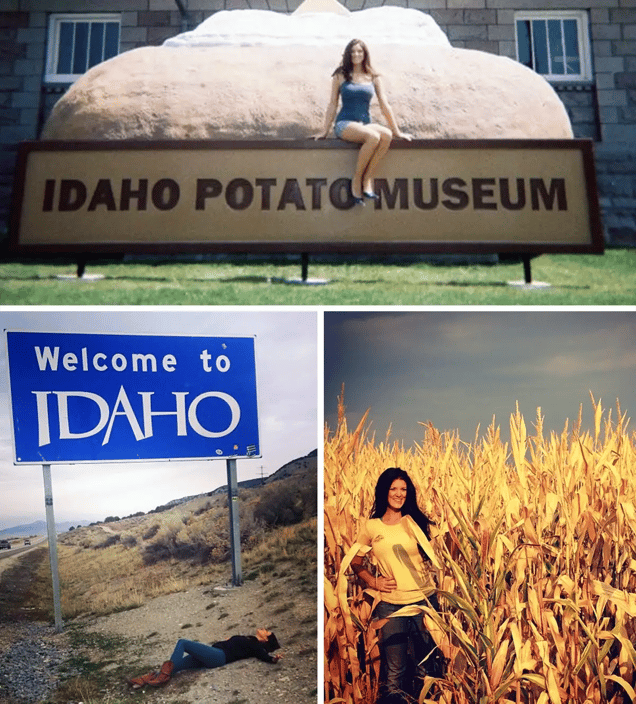
Photos courtesy of Kristie Wolfe
Wolfe dropped out of high school and worked a variety of odd jobs, from running a small clothing boutique to sorting plastics at a recycling plant, before eventually landing her “dream job” at a potato factory.
She was given the “worst job at the facility” — unloading sacks of dirt-laden potatoes — but found the grueling 14-hour days to be meditative.
And she soon found joy in living a simple, no-frills lifestyle.
Around 2010, Wolfe, then 27, read about the burgeoning tiny house movement, a community of hyper-minimalists who live in <400-sq.-ft. abodes, many of them self-built.
She was instantly enamored.
With savings from her $13/hr factory gig, she bought a used trailer ($300), and ¾ of an acre of land ($5k) on Craigslist — a “miserable little piece of dirt” on the outskirts of Boise.
Over the course of a month, she built her own 97-sq.-ft. off-grid tiny home from scratch, at a cost of $3k, using her mom’s minivan to transport lumber.
“The house was basically a shed on wheels,” she says. “But living without stuff just felt great to me.”
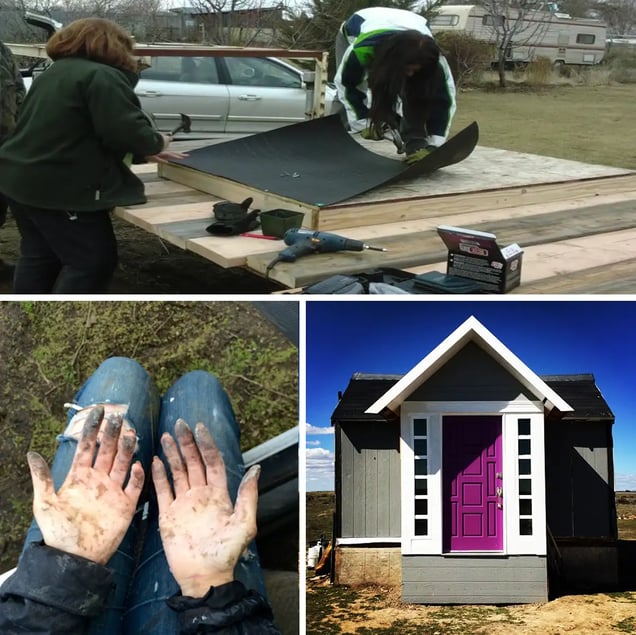
Top: Wolfe and her mom tag-teaming the build; Bottom: Dirty hands after a long day’s work, and the final product (photos courtesy of Kristie Wolfe)
Wolfe didn’t have much money to her name, but living off-grid and mortgage-free reduced her bills to almost nothing.
And the experience of building a house from the ground up gave her the confidence that she could do it again — this time, as a source of income.
The Big Island Treehouse
In 2013, while scouring Craigslist for cheap land, Wolfe came across a listing for a ½-acre lot on the rainy side of the Big Island in Hawaii.
Wolfe had never been to Hawaii, but she knew it was a tourist hot spot. And though the plot was off the beaten path, she saw potential.
The seller was a guy in Indiana who was offloading all his assets. His asking price was $8k, and Wolfe, short on cash, worked out a deal with him: $1k down, $200/mo with 0% interest.
She packed a small bag of tools and boarded a plane to Hawaii with her mom, not knowing what to expect.
When she arrived, the road to the lot was overgrown, flooded, and strewn with rusty, abandoned cars. Wolfe hired a guy to clear out the route, then bought a chainsaw and spent several days cleaning up the lot.
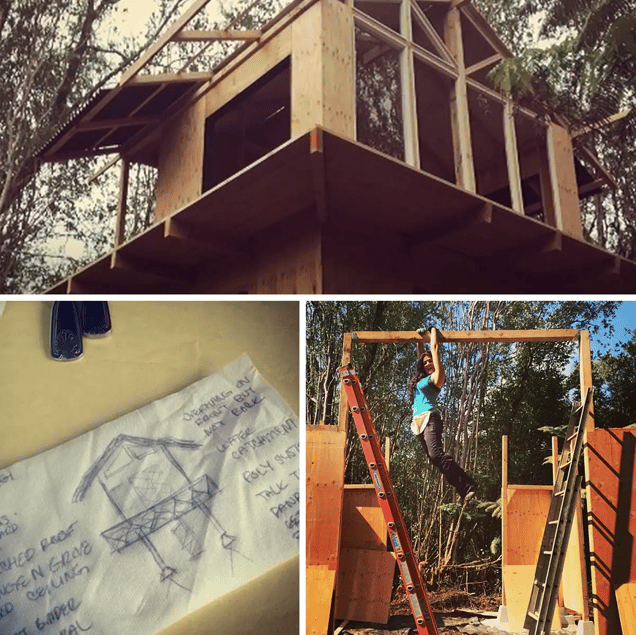
Top: The build in the early phases; Bottom: A literal napkin sketch blueprint, and a little fun on the job (photos courtesy of Kristie Wolfe)
She didn’t have a blueprint, or an architect. But she did have napkins and graph paper. And she also had a vision: She wanted a treehouse.
While researching the build, Wolfe was told there were stone-set ways things had to be done. “People always think certain things are impossible,” she says. “But when you’re pushed into a corner, you just figure it out.”
Due to her financial limitations, Wolfe had to get creative:
- She affixed bamboo mats over plywood for exterior walls
- She rigged up a bed frame out of two-by-fours and cardboard tubes
- She used planter boxes to frame circular windows
- She built an outdoor hanging bed out of a repurposed trampoline
With just her mom, some tools, and a couple $27 strap winches, Wolfe built the entire 230-sq.-ft. structure in 2 months.
Her total cost: $11k — nearly every penny she had.
Wolfe’s biggest expenses were in setting up the shelter with an off-grid system: solar, inverters, a rainwater catchment system, and a battery-powered propane water heater. She also had to buy an $800 “piece of junk” truck for hardware store trips, which she re-sold at cost when she left the island.
The build was unpermitted — a common situation in Hawaii — which made it impossible to get insurance. But the investment, she says, was so minimal that it wasn’t a concern.
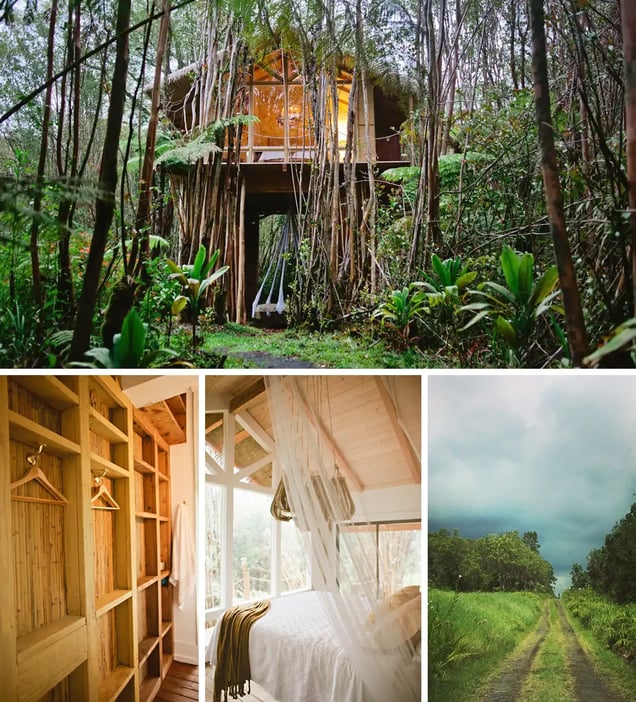
The final Hawaii build (photos courtesy of Kristie Wolfe)
Wolfe’s hard work quickly paid off.
She listed the property on Airbnb in 2014 for $250/night. The novelty factor, and some fortuitous press from tiny home influencer Kirsten Dirksen, almost immediately resulted in a booked-out calendar.
In just the first 100 days of being operational, Wolfe recouped her entire investment.
“I could’ve stopped right then and there and chilled with the income,” she says. “But I have no chill.”
It wasn’t long before she set her sights on another build.
The Hobbit Inn
In the wake of building her Hawaii house, Wolfe learned something that changed her investment philosophy.
She realized that chasing hot tourist destinations wasn’t a good strategy. Land in those places was far pricier, and competition was more intense; instead, she decided to focus on rural, traditionally undesirable sites.
“I decided to build properties so cool that people would come to me,” she says. “The house itself — not the location — would be the destination.”
In early 2015, Wolfe scouted a 5-acre plot of discount land in Orondo, Washington, for $18k that only required 20% down with a 3-year payoff. It was a rural area surrounded by rolling green hills that looked like something out of a Tolkien book.
So, Wolfe decided to build a hobbit house.
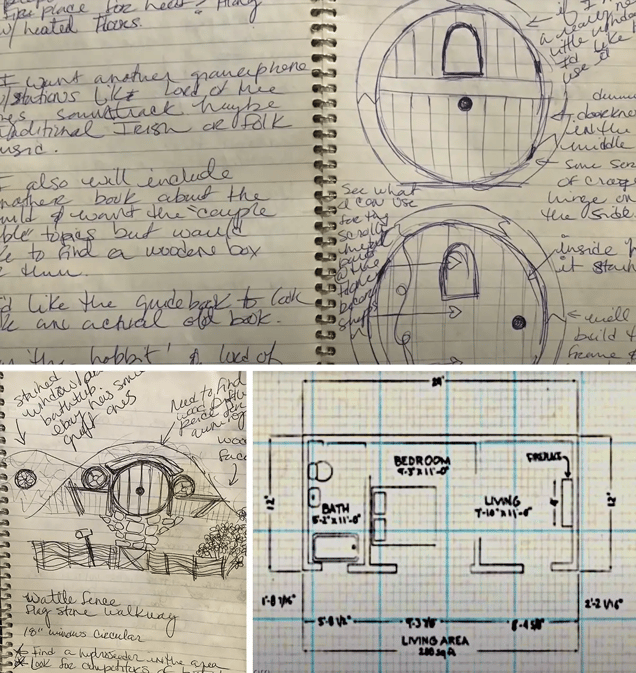
Early sketches and notes on the hobbit build (photos courtesy of Kristie Wolfe)
Before starting, Wolfe studied up on hobbits, rereading The Lord of the Rings and fact-checking things on hobbit enthusiast forums.
She created a character in her mind — a woodworking hobbit — and built the house as accurately as possible, as if he inhabited it. In lieu of kitschy Frodo action figures, Wolfe built a woodworking bench with whittling tools, a giant circular door made out of a cable spool, and deep-set “hobbit windows.”
Staying true to the integrity of hobbit living meant building the home largely underground, which posed serious challenges.
“There wasn’t anything online about building underground within my budget,” she says. “So, I just kind of winged it.”
Wolfe hired an excavator to carve out the side of a hill, then constructed the home using 2’x6’ treated lumber sheeted with ¾” plywood. She affixed the 288-sq.-ft. structure with a tin roof and installed moisture-wicking insulation to protect it from water damage.
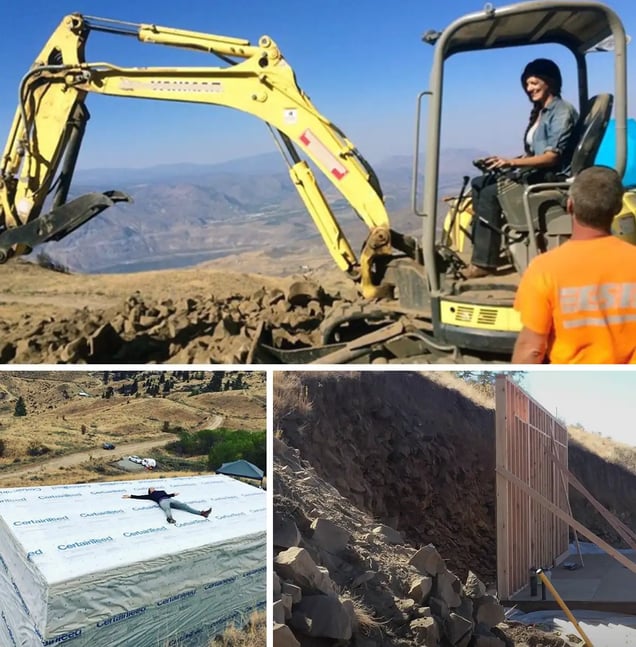
Scenes from the hobbit build (photos courtesy of Kristie Wolfe)
Once again, she had to get crafty to stay on budget:
- She used reclaimed wood and materials
- She built light fixtures out of willow branches
- She built her own pull-chain toilet (typically $800) using a lamp chain, a pipe, and an wall-mounted tank
- She bought used windows for $10
Similar to her Hawaii project, everything was built off-grid, with a 3k-watt solar inverter and a 2k-gallon water tank.
“Going off-grid opens up your options for cheap land,” she says. “But you don’t get city utilities, there’s often no infrastructure, and you can’t just call a random electrician when your generator goes out.”
This often leads to stressful situations.
Last year, during a nasty cold spell, Wolfe had to cancel a week’s worth of guests and drain a frozen water line in single-digit temperatures. When the septic line froze, she had to drive 8 hours from Boise to Washington with a truck full of lumber and build an outhouse from scratch.
“Most of the time, no matter what goes wrong, if you can be really transparent about the situation and try to make it right, guests will be understanding,” she says.
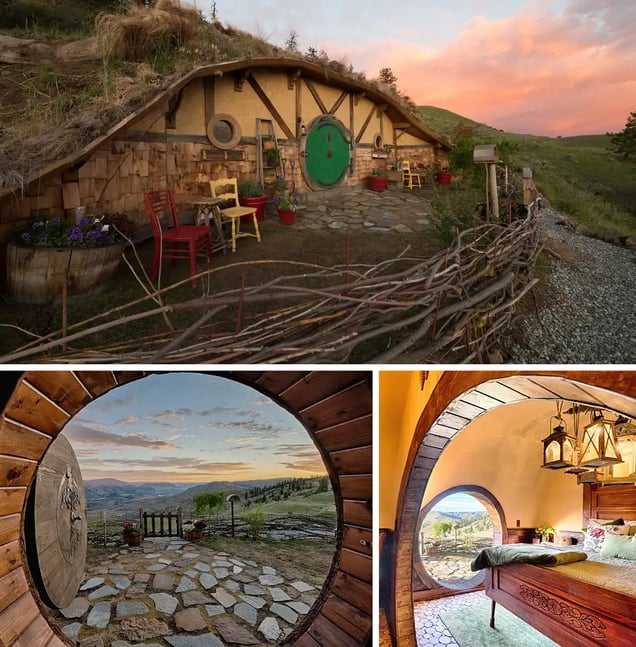
The final hobbit build (photos courtesy of Kristie Wolfe)
On Airbnb, the property has exceeded her wildest expectations.
While the Hawaii treehouse attracted mainly honeymooners, the Washington property has become a go-to destination for hobbit enthusiasts from around the world.
Today, the home (~$400/night) is booked so far in advance that the average guest has to wait 430 days to stay there.
Though Wolfe was hesitant to share exact numbers, the hobbit hole’s extraordinarily high occupancy rate (90%+) likely grosses in excess of $100k/yr before accounting for Airbnb’s cut (3%) and other overhead costs (property management, repairs, land taxes, etc.).
Crystal Peak Lookout
Shortly after finishing her hobbit hole, Wolfe came across a listing for an old fire lookout tower in Fernwood, Idaho (pop. 684).
At $67k for the structure and land, it was more than 3x pricier than anything else she’d purchased.
But it wasn’t generating any interest and she was able to work out a deal with the realtor, financed through her other properties’ income: $1.1k/month for 5 years, with 6% interest.
Built to survey forest fires, lookouts once numbered in the thousands, but have since dwindled to a few hundred.
Most are built on federal land and impossible to own — but this one was special. The owner had bought it from an elderly couple in 1983 for $1 and transported it to a private plot, which he paid for by logging the land.
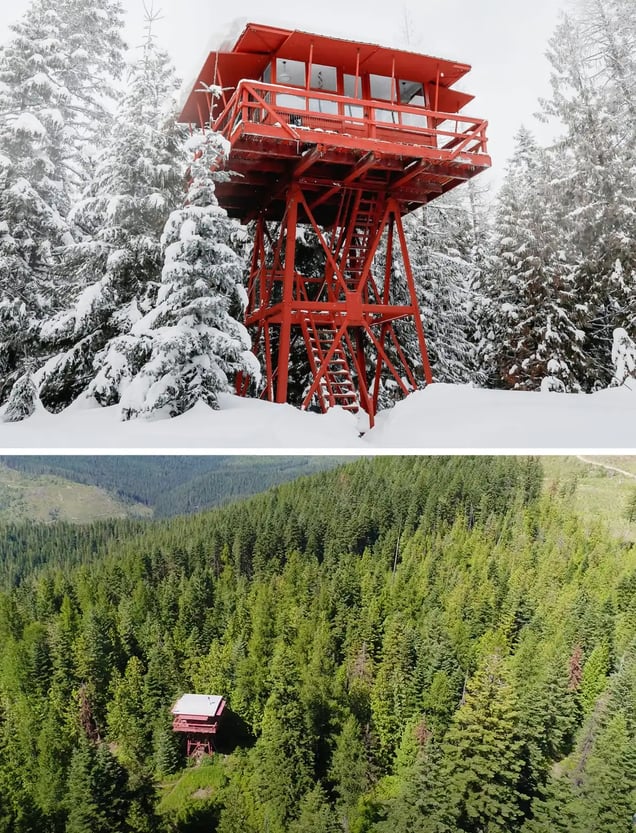
The fire lookout in Salmon, Idaho (photos courtesy of Kristie Wolfe)
When Wolfe first journeyed to the property, it was overrun with rats and in a state of disrepair. She lived there for 2 months, mostly in complete solitude, taking care to restore the lookout and maintain its original charm.
She hauled up a wood-burning stove, vintage cast-iron pans, an antique coffee grinder, and the lookout’s original log book.
A dilapidated shed was converted into a working sauna with a bucket shower, and an outhouse was installed nearby.
The main lookout is tiny (14’x14’), but it sits on a 25-foot-tall perch and boasts 360-degree views of forestland.
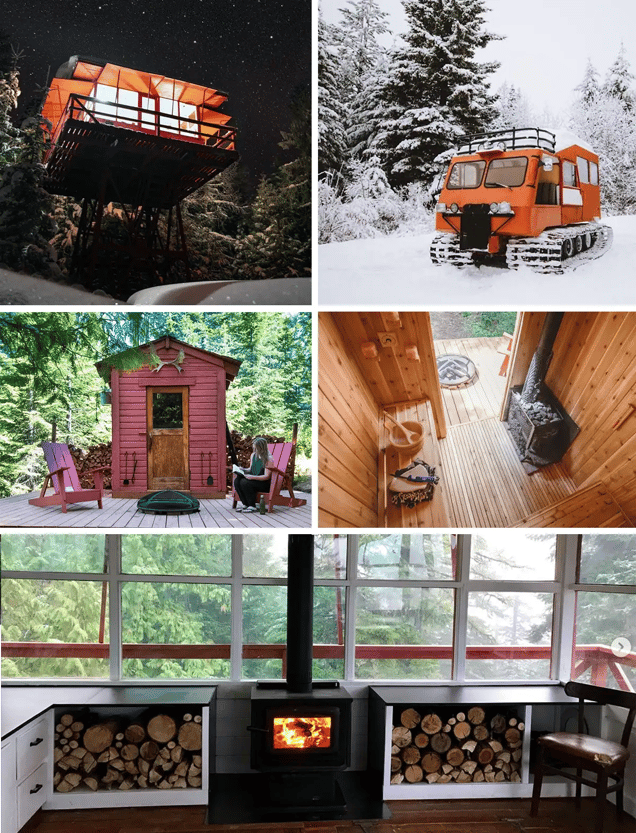
The lookout comes with a restored 1964 Thiokol snowcat for the caretaker to bring guests up the road in winter (photos courtesy of Kristie Wolfe)
At $200/night, the lookout is miles from the nearest town and requires driving down a rough dirt road and hiking up a steep driveway. There’s no cell service, and water and power are limited.
Wolfe says guests who book stays there know what they’re in for: a rugged, peaceful retreat — not a cushy glamping experience.
Guests may have to use a butane-powered camping stove to cook dinner and chop their own wood using a kindling cracker, but they’re rewarded with frequent visits from moose and a symphonic overture of bird calls.
With 3 successful properties in 3 different states, Wolfe decided to turn back to her roots — by building a house out of a giant potato.
Big Idaho Potato Hotel
Years earlier, in the odd-job phase of life, Wolfe had landed a gig with the Idaho Potato Commission, touring the US in a giant concrete potato affixed to a truck.
While building her fire lookout, she learned that the commission was upgrading its potato to a fiberglass model.
“I sent them a message like, ‘Hey, what’s the plan with that old potato?’” says Wolfe. “They had no idea what to do with it, and they actually ended up gifting it to me.”
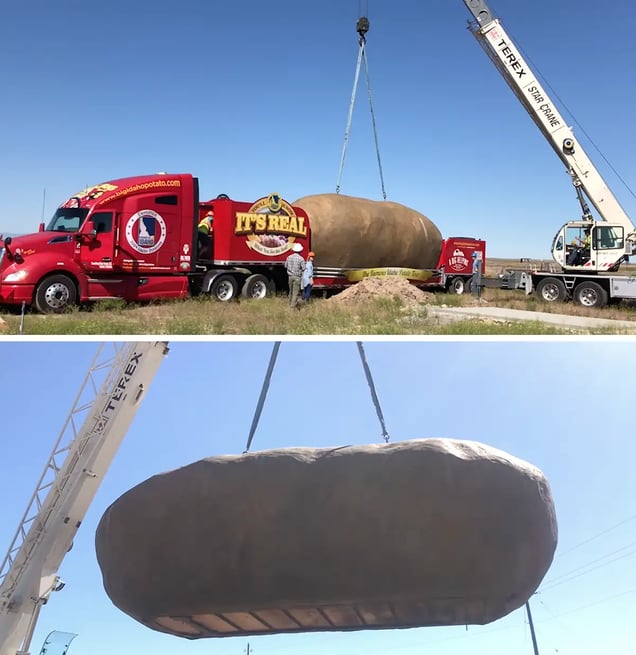
The potato in transit (photos courtesy of Kristie Wolfe)
In a viral PR play, the commission used a crane to offload the 12k-pound, 28-foot-long concrete potato on Wolfe’s land outside of Boise, and announced it was beginning a second life as a vacation rental.
The move generated more than $1m in free press for the commission and drummed up international demand for the listing before it was even built.
Wolfe hollowed out the inside of the potato, used spray foam for the walls, and added ventilation, plumbing, and electrical systems.
To keep things economical, she made her own lighting out of fishing traps and antlers, built shelving units with old railroad spikes from the nearby tracks, and used a $60 pet fence dome in lieu of a $1k+ skylight. The bathroom, which includes a fireplace and brick-inlaid tub, was built out of a converted grain silo.
And in case guests get lonely, a Jersey cow named Dolly (after Dolly Parton), lives on the property year-round.
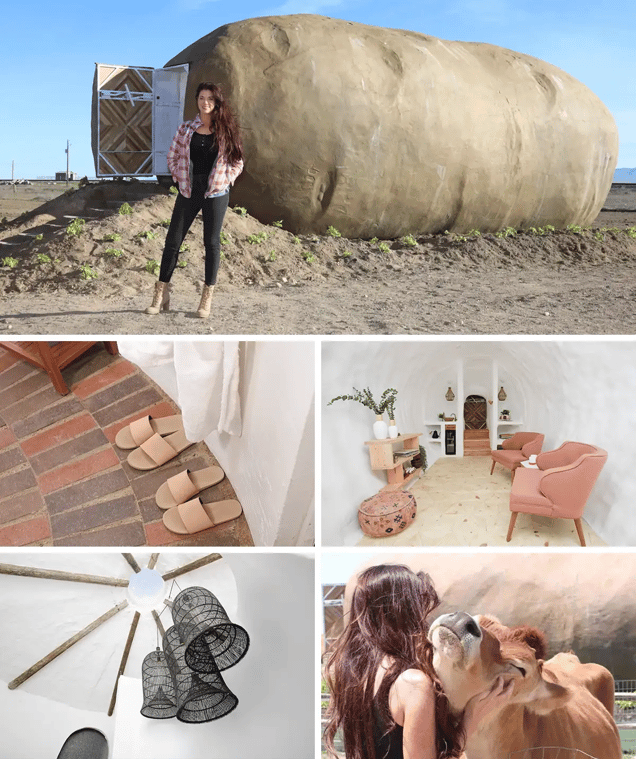
The potato comes with a Jersey cow named Dolly (photos courtesy of Kristie Wolfe)
Like Wolfe’s other properties, the 200-sq.-ft. potato is often booked out months in advance, at $200/night.
“It’s in the middle of nowhere. It’s just 400 acres of farmland in every direction,” says Wolfe. “But people come from all over the world to stay here. Everyone loves potatoes.”
Always on the move
Wolfe’s strategy of creating unique experiences rather than going after tourist markets has been endorsed by Airbnb.
Searches for “unique” properties were up 94% on the platform last year, and an Airbnb spokesperson tells The Hustle that hosts of unique abodes made $300m globally in 2020.
The 39-year-old minimalist declined to share the total revenue her properties bring in, but says it’s enough to not have to worry anymore about financing most new builds.
Wolfe invests nearly all of her proceeds into other properties and already has several other one-of-a-kind projects in the works:
- She bought a lakeside property in Salmon, Idaho, for $120k and is converting it to look like a shipwreck house, complete with a treasure hunt for kids.
- She snapped up 40 more acres near the hobbit house and is expanding it into a hobbit village.
When I called Wolfe last month, she was somewhere in remote Oregon, waiting for a prefab structure to get shipped from Estonia. She says it’ll be used to create a property that can only be accessed by boat.
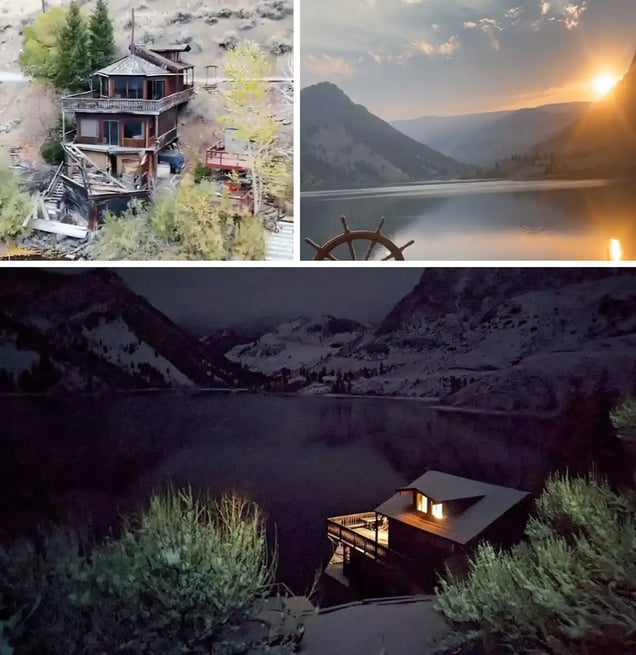
Progress at the shipwreck house in Salmon, Idaho (photos courtesy of Kristie Wolfe)
Budgeting has become a bit more of a challenge during the pandemic.
During a remodel of a deck at the shipwreck house, for instance, the price of plywood fluctuated from $45 to $105 per sheet due to lumber shortages.
But she now has a more rigid system in place for new properties, which helps alleviate some of the management pain points:
- She hires someone on Upwork to write a press release
- She gives away a few free stays to get user feedback and high-quality photos
- She outsources her property management to the automated platform Guesty
- She finds a local caretaker in every new location to clean and add special touches to the property (fresh flowers, local coffee, etc.)
“The most common question I get is how I find people to take care of my properties in such rural locations,” she says. “My trick was to change the ad from ‘housekeeper’ to ‘caretaker.’ It sounds much more appealing, and the difference in the quality of applicants is night and day.”
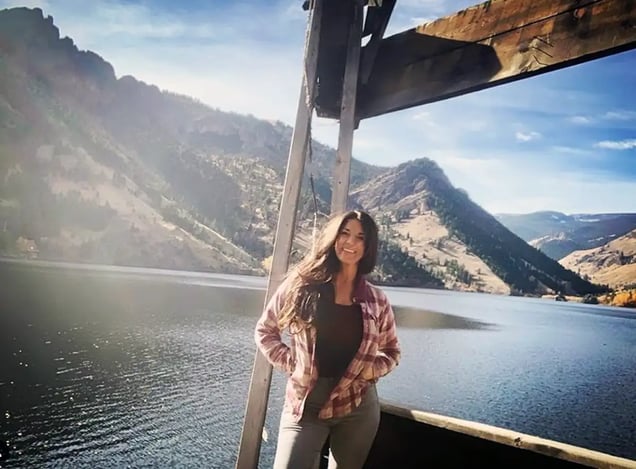
Out on a build (photo courtesy of Kristie Wolfe)
Building properties around the country is a gritty lifestyle.
Wolfe typically camps out in unfinished shelters for months on end until they’re finished, often without electricity, plumbing, or running water. On occasion, she’s joined by her mom, who reminds her to eat something.
“I really live for that state of flow, where you forget to eat and don’t really need anything,” she says. “You’re just consumed by the creative process and the problem-solving. It’s like meditation.”
Though Wolfe has a home base — a 147-sq.-ft. tiny house — in Boise, she prefers to spend nearly every week on the road.
She proudly calls herself a “full-time builder,” and wouldn’t have it any other way.
“If you can build,” she says, “you’ll always be OK.’”
BONUS: Want to read more about unique vacation rental owners? Check out our profile of the woman who owns one of Airbnb’s most-booked properties — a weird little treehouse in the California redwoods.

